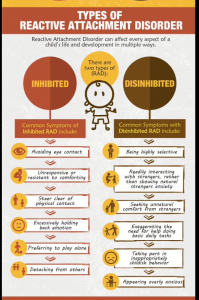


The symptom characteristics include consistent patterns of withdrawing behavior and an inability to seek comfort from safe adults or caregivers.
#RAD DISORDER KIDS IN SCHOOL MANUAL#
Inhibited RAD SymptomsĪccording to the American Psychiatric Association’s Diagnostic and Statistical Manual of Mental Disorders Fifth Edition (DSM-5), inhibited RAD symptoms appear in children between the ages of 9 months and 5 years old. They do not meet criteria for the autism spectrum. Rearing in unusual settings that severely limit opportunities to form selective attachments (institutions with high child-to-caregiver ratios)Ĭhildren diagnosed with RAD show emotional disturbances before age 5, but must have a developmental age of at least 9 months.
:max_bytes(150000):strip_icc()/adhd-attention-deficit-hyperactivity-disorder-included-definition-symptoms-traits-causes-treatment-5084784_final-bc92546bc9df465ea7f13fc423c2085b.jpg) Repeated changes of primary caregivers that limit opportunities to form stable attachments. Social neglect or deprivation in the form of persistent lack of having basic emotional needs for comfort, stimulation and affection met by caregiving adults. To be diagnosed with RAD, a child must have experienced a pattern of extremes of insufficient care as evidenced by at least one of the following: Episodes of unexplained irritability, sadness or fearfulness that are evident even during nonthreatening interactions with adult caregivers. Limited positive moods/emotions (joy, interest and alertness). Minimal social and emotional responsiveness to others. A persistent social and emotional disturbance characterized by at least two of the following:. Rarely or minimally responding to comfort when distressed. Rarely or minimally seeking comfort when distressed. A consistent pattern of inhibited, emotionally withdrawn behavior toward adult caregivers exhibited by:. Signs and Symptomsįor a diagnosis of RAD, a child must exhibit the following symptoms: In the case of adopted children, early years in an unstable or abusive home may contribute to the disorder. Some have lost parents or caregivers or experienced multiple caregiver changes. Some children who develop RAD have received inadequate care outside their home – like in a hospital, residential program, foster care or orphanage. This rare condition is known as reactive attachment disorder (RAD). If a baby or young child experiences a severe disruption in these early relationships, especially if he or she has been neglected or physically or emotionally abused, the child may develop serious problems with emotional attachments to others. What is Reactive Attachment Disorder in Children?īabies develop attachments to parents or caregivers when those adults comfort them and otherwise attend to their needs.
Repeated changes of primary caregivers that limit opportunities to form stable attachments. Social neglect or deprivation in the form of persistent lack of having basic emotional needs for comfort, stimulation and affection met by caregiving adults. To be diagnosed with RAD, a child must have experienced a pattern of extremes of insufficient care as evidenced by at least one of the following: Episodes of unexplained irritability, sadness or fearfulness that are evident even during nonthreatening interactions with adult caregivers. Limited positive moods/emotions (joy, interest and alertness). Minimal social and emotional responsiveness to others. A persistent social and emotional disturbance characterized by at least two of the following:. Rarely or minimally responding to comfort when distressed. Rarely or minimally seeking comfort when distressed. A consistent pattern of inhibited, emotionally withdrawn behavior toward adult caregivers exhibited by:. Signs and Symptomsįor a diagnosis of RAD, a child must exhibit the following symptoms: In the case of adopted children, early years in an unstable or abusive home may contribute to the disorder. Some have lost parents or caregivers or experienced multiple caregiver changes. Some children who develop RAD have received inadequate care outside their home – like in a hospital, residential program, foster care or orphanage. This rare condition is known as reactive attachment disorder (RAD). If a baby or young child experiences a severe disruption in these early relationships, especially if he or she has been neglected or physically or emotionally abused, the child may develop serious problems with emotional attachments to others. What is Reactive Attachment Disorder in Children?īabies develop attachments to parents or caregivers when those adults comfort them and otherwise attend to their needs.




:max_bytes(150000):strip_icc()/adhd-attention-deficit-hyperactivity-disorder-included-definition-symptoms-traits-causes-treatment-5084784_final-bc92546bc9df465ea7f13fc423c2085b.jpg)


 0 kommentar(er)
0 kommentar(er)
